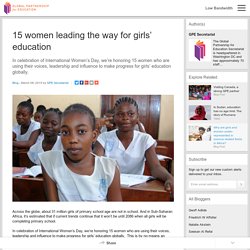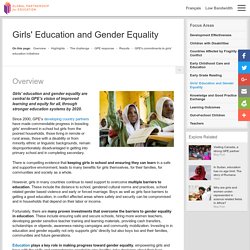

Kayla Dobrzyn
Michelle Obama: How educating girls can save the world (opinion) Sometimes it's not even safe for girls to attend school in the first place, since their commutes to and from school can be dangerous, and they sometimes even face sexual harassment and assault at school.

Raphina wakes up early each morning, cooks for her family, cares for her younger siblings, and goes to work at a local market -- all before she even gets to school. But she still attends class each day, working especially hard in science and math so she can fulfill her dream of becoming a nurse. Rihab Boutadghart lives in a remote part of Morocco near the Sahara Desert. While Morocco has made huge strides in education, and nearly all girls there attend elementary school, girls in rural areas often live far from the nearest middle and high schools, so many of them drop out of school by the time they turn twelve.
You Won't Believe How Many Countries Still Won't Allow Women The Right To Education. Growing up in a privileged society, it's easy to take certain freedoms for granted.

We quickly forget that access to a quality education is not universal, especially for the women of the world. There are well over 20 prominent nations, which continue to discriminate against females by preventing them from learning. In these countries, gender inequality in education not only stifles the development of women, but also their sense of self-worth. Equal education, besides being a basic human right, is an essential tool for achieving social change, improved health and decision-making.
No Girl Left Behind – Education in Africa. By Claudia Costin, Senior Director for Education at the World Bank, Silvia Montoya, Director of the UNESCO Institute for Statistics and Karen Mundy, Chief Technical Officer at the Global Partnership for Education.

On International Women’s Day, let’s remember the challenges girls face in education A girl in school in Kenya. Credit: James Otieno/UNESCO EFA Report What would your life be like with only five years of schooling? For many girls around the world, this is the most education they can expect and they are the lucky ones. Sunday is International Women’s Day, an occasion to celebrate the tremendous progress achieved in securing access to a basic education for girls in the poorest countries. We live in a world where violent extremists are bent on destroying the lives of school girls, their families and communities.
Breaking down the barriers is a joint effort No single organization can break down the complex barriers facing girls, especially in Africa. More qualified teachers needed. 15 women leading the way for girls’ education. Across the globe, about 31 million girls of primary school age are not in school.

And in Sub-Saharan Africa, it’s estimated that if current trends continue that it won’t be until 2086 when all girls will be completing primary school. In celebration of International Women’s Day, we’re honoring 15 women who are using their voices, leadership and influence to make progress for girls’ education globally. This is by no means an exhaustive list – just a few out of millions of women who are helping make change happen. 1.
Michelle Bachelet, President of Chile During her second non-consecutive term, President Bachelet in 2014 ushered through a far-reaching education reform program that raised the government’s investment in public education. 2. By daring to go to school as a young teen, Malala defied Pakistani extremists and their violent attacks and became a global icon for the importance of educating girls. 3. 4. Through her philanthropy and advocacy at the Graça Machel Trust, Ms. 5. Mrs. Girls' Education and Gender Equality. Girls' education and gender equality are central to GPE's vision of improved learning and equity for all, through stronger education systems by 2020.

Since 2000, GPE's developing country partners have made commendable progress in boosting girls' enrollment in school but girls from the poorest households, those living in remote or rural areas, those with a disability or from minority ethnic or linguistic backgrounds, remain disproportionately disadvantaged in getting into primary school and in completing secondary. There is compelling evidence that keeping girls in school and ensuring they can learn in a safe and supportive environment, leads to many benefits for girls themselves, for their families, for communities and society as a whole. However, girls in many countries continue to need support to overcome multiple barriers to education. These include the distance to school, gendered cultural norms and practices, school related gender based violence and early or forced marriage.
Why it’s hard for girls in rural India to stay in school. JUDY WOODRUFF: Fifteen years ago, the United Nations set a goal: By this year, every child in every nation should be able to obtain free basic education.

While the number of children out of school has been cut almost in half, there are still 57 million worldwide who have never set foot in a classroom. Hundreds of millions more have dropped out. PBS has been reporting on the global education crisis by following six children from different countries over 12 years, part of WNET’s documentary series “Time for School.”
Tonight, we travel to India, where nearly 100 percent of children start primary school.